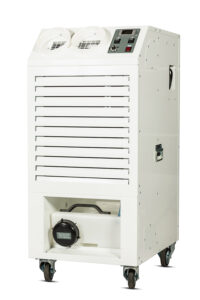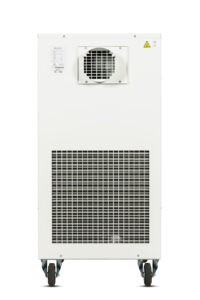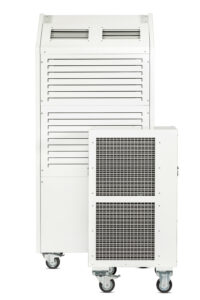Choosing the right unit for your application is important as you need to make sure you’re getting enough cooling, listed below are some of the more common applications for portable air conditioning units together with some suggested installation arrangements that may suit.
Rooms with opening windows which need to be locked at night
The most common application for temporary air conditioning in either offices, retail and domestic settings.
It is simple to set up and the window can be closed and locked at night by withdrawing the monobloc air conditioner exhaust tube. The correct choice of exhaust hose end fitting will allow the window to be closed to leave only a small gap and will look neater than having the pipe hang out of the window.
Rooms with windows that can be left open a little over night
Where it is possible to leave the air conditioning DX or heat exchanger box positioned outside, a water cooled split air conditioner can be used. This is also possible where a small hole, approximately 60mm diameter, can be cut in the window or drilled through a wall. The connection between the indoor and outside parts of the unit can be passed through the hole and re-connected outside.
The condensate generated by the air conditioner inside will be discharged to the outside section and dispersed to atmosphere so some dripping might occur which needs to be taken into account. If this is the only obstacle to using a split unit and this type of air conditioner is preferred, then arrangements can be made for the condensate to be discharged elsewhere.
A split unit operates in the same way as an installed system in that the air in the room is re-circulated through the indoor part while the condenser section (the part of an air conditioner that creates warm air) isn’t in the room you’re cooling, like it is with a monoblock. Split units are considered much more efficient than monoblocks and, in theory at least, a split with the same cooling capacity as a monobloc unit should be much more effective in cooling the room, particularly in hotter weather.
Small server rooms within air conditioned offices
For small server or comms rooms without a windows and requiring cooling, a monobloc air condtioner with exhaust hose long enough to reach a ceiling void or even direct the air across into an adjacent room will often do. We would always recommend that the heat from the portable air conditioning unit in server room is discharged directly outside, but if the main office is air conditioned then it can be acceptable to rely on the office air conditioning to take that heat away. After all, before using any cooling, the server heat would have been contributing to the temperature of the surrounding area, anyway. A portable air conditioner installed appropriately will take the heat away from the server room in a more positive way and help the temperature of the servers be controlled.
It is important to check that the ceiling void above the server room is open to adjacent areas so the hot air can be ducted away from the server room and vented away, otherwise overheating of the servers might well continue.
Where no ceiling void is available, it may be necessary to discharge to heat directly into the adjacent office or use a duct with in line fan (such as a VF250) to take the heat away from the area.
Cover during planned maintenance or emergency breakdown in purpose built server rooms or data centres.
Where the area to be cooled is deep within a building and a significant amount of heat needs to be dissipated, such as a larger server/machine room, laboratory or production area, a water cooled split air conditioner can be used.
The heat is transferred from the indoor unit to the outdoor unit by circulating water which means that the connecting hosing can be up to 35M long. This allows the heat from the room to be taken to a convenient outdoor location. At up to 7.3KW these are powerful air conditioning units and because they’re split units then any number can be used in the same area without affecting ventilation rates, to meet large cooling demands.
Air conditioning failure in sealed buildings.
In buildings with an integrated HVAC system it is common for the windows that can’t be opened, which means that any failure of the A/C system can lead to a serious overheating problem very quickly.
The use of monobloc units discharging their heat into the installed ventilation system to get rid of it is often the only practical option. It is important that the ventilation system is kept running at all times, particularly where the temporary system is relied upon to maintain servers, computer systems and other critical infrastructure.
Although quick and easy to get up and running in an emergency, evaporative cooling isn’t really an option here either as the limited ventilation will not cope with the increased humidity they can create so working conditions could quickly deteriorate. Again, because of the increase in humidity they can create evaporative coolers are also recommended for use in server rooms.
Marquees, events and outdoor locations
The high level of ventilation and poor insulation usually associated with temporary structures such as marquees, plus the fact they’re usually in open outdoor locations make the use of portable air conditioning units difficult (unless used as spot coolers). A more suitable solution may well be evaporative coolers.
With evaporative cooling a constant high volume of fresh air passing through the units is needed to maximise performance and help keep humidity to a minimum, with that in mind evaporative coolers are often ideally suited to marquees and outdoor events.
Basement level cooling
Thanks to a combination of poor insulation and insufficient ventilation basement areas with people working in them can become over heated in summer. Heat generated by staff, computers, lighting photocopiers, server cabinets and other electrical equipment will all contribute towards a stuffy, unpleasant working environment.
Heat needs to be properly exhausted outside rather than into adjacent areas so that it doesn’t find it’s way back to the basement. The distance to outside can often be prohibitive for standard monoblocs so a water cooled split air conditioning unit is often the best solution. The distance between the indoor unit and the outdoor unit can be as much as 35M and the interconnecting umbilical line is relatively small at about 50MM diameter and is very flexible.
Evaporative cooling would probably not be as effective as desired it requires a constant stream of fresh air or you risk increasing the RH level and evaporation would cease making the cooler no more than a fan in a very humid room.
Server room A/C breakdown emergency or A/C off over night
Where a short term solution is required for emergency cooling of a room without windows such as an internal server room, it may be acceptable to simply discharge the heat into the adjacent room with a monobloc unit, via the door. This will allow the server temperatures to be controlled and the total amount of heat entering the adjacent office will not be significantly more than exists before cooling is installed as the heat from the servers/UPS etc will make it’s way into the office anyway.
Large warehouse or factory areas
In large warehouse environments such as distribution hubs, factories and even workshops where large floor areas combined with high roofs make comfort cooling impractical, it’s often more appropriate to provide operatives with localised or ‘spot’ cooling.
A cool air flow to the workstation from an industrial monobloc air conditioner will allow relief from high temperatures, reduce stress and hopefully improve productivity. Where staff have to move around a lot then spot cooling can be used to provide respite areas for relief from the heat.
The heat from the spot coolers is discharged to high level in the building where it can be vented either by natural ventilation or by roof extract fans.
Evaporative cooling is also an ideal solution for this type of application, especially given their relatively low energy consumption when compared to portable air conditioning units.
Semi permanent water cooled split installation for regular use
Where cooling is needed all year round or where it is needed every summer, a semi permanent installation of a split unit can be achieved by simply drilling through the wall or having a hole cut in the window glass. The heat exchanger section of the unit can then hung on the wall outside while a longer length of the connecting hose can be inside which allows the cooling section of the unit to be sited in the most effective place.
With this type of installation the unit will operate in a very similar way to fixed installation air conditioning, constantly recirculating the air in the room through the A/C unit for maximum cooling effect and dumping the heat outside the building.
Exhibition stand cooling
Thanks to all the lighting, computers, AV equipment and poor ventilation within the aisles, exhibition halls can quickly become uncomfortable during the warmer months.
As space is usually limited on exhibition stands then they can be spot cooled from a unit hidden away behind the stand or set design, with the cool air ducted onto the stand via a neat grill or diffuser. The other benefit to this is that it also keeps any noise from the air conditioner away from visitors and doesn’t compromise the appearance.
The monobloc unit exhaust can be ducted out though the stand wall or up through the stand ceiling. Heat is simply dissipated into the exhibition hall where it is vented at high level.
If space to locate the unit really is a problem then there have been times where it has been installed on top of the stand!
Cooling units with long exhaust requirement
Spaces that need cooling and need very long exhaust duct pose a particular problem. The maximum exhaust length on any of our MCM units is 10M and if more is used then not only is performance compromised, particularly in hotter weather, but it could lead to compressor failure outside of warranty cover. Should more than 10M be required then it is possible to use an inline fan such as our VF range, which could allow a further 10M of ducting to be fitted.
Portacabin or temporary building comfort cooling
Accommodation in portacabins usually presents a pretty serious overheating problem in summer through direct solar gains and very poor insulation, while the lack of adequate ventilation only exacerbates the problem.
The monobloc air conditioner is a simple, effective solution that can be easily installed and the exhaust duct taken out straight though the wall, window or roof. Not only will the cooling be much appreciated but the extra air movement generated by the unit will also help maintain a more comfortable environment within the portacabin.
When installing portable air conditioning units in this type of building then please pay attention to the type of grill or diffuser used as any obstruction to the air flow could well have a negative effect on performance. Where the exhaust is taken to a hole cut in the wall adequate ventilation into the portacabin is needed to ensure that the exhaust air flow is not restricted. Where a window is used for exhausting the unit, the free area of window opening is normally adequate ventilation.
When looking for a portable cooling solution then we’d highly recommend seeking the advice of a climate control specialist, every application is unique and there’s no substitute for a thorough site visit and evaluation from a trained professional. If you are looking for help and advice on who to turn to then please do not hesitate to contact us, we’ve been supplying the climate control industry for over 30 years and are more than happy to recommend a trustworthy specialist.


